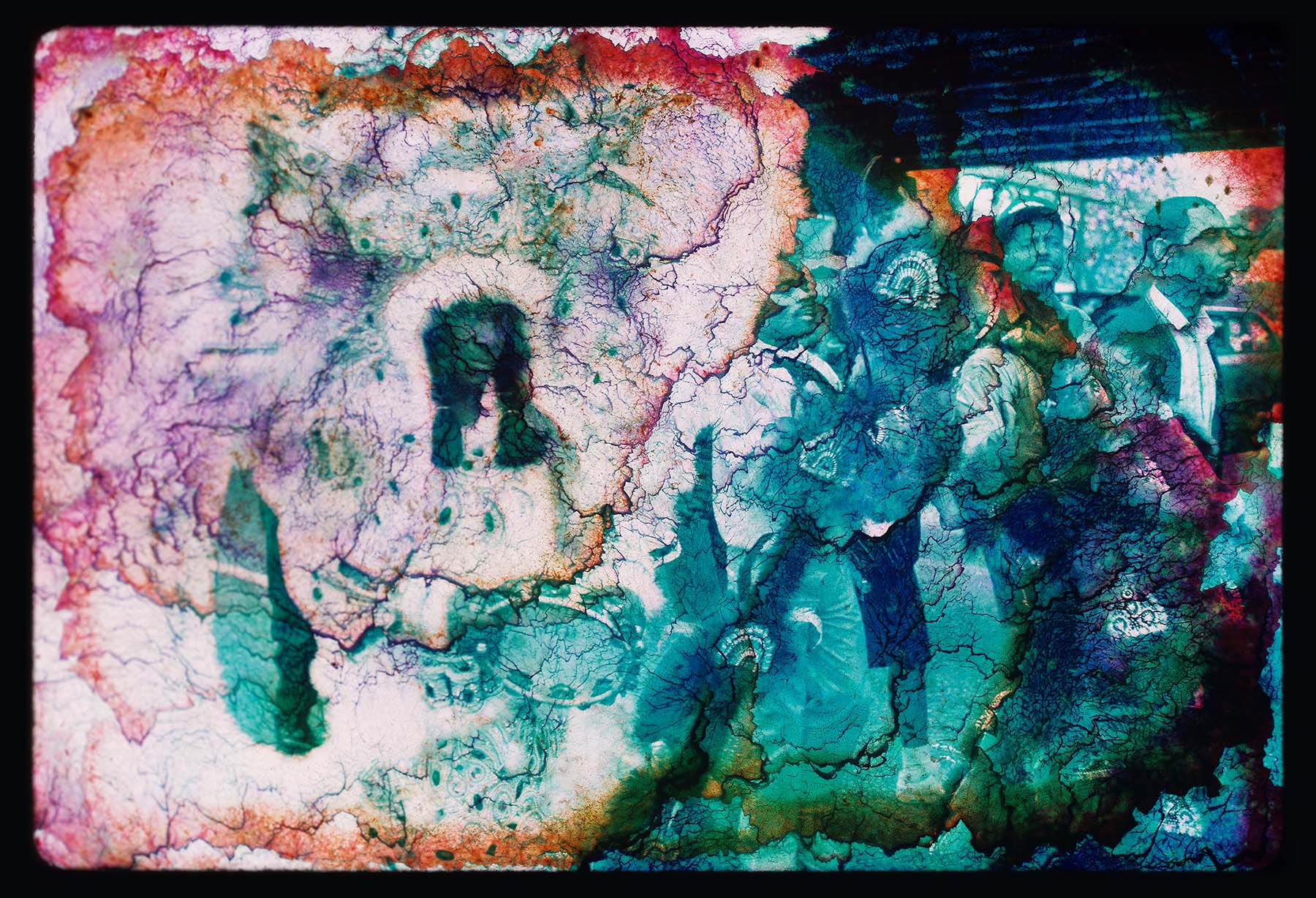Collisions of Race and Place
August 26, 2019
Landscape architect and essayist Kofi Boone reflects on a photograph by Southbound artists Keith Calhoun and Chandra McCormick. As part of our Call & Response series in conjunction with Southbound: Photographs of and about the New South, we’ve asked artists, writers, and poets to respond to a photograph of their choice in the form of short written pieces.
By Kofi Boone

Keith Calhoun and Chandra McCormick, Big Chief Allison "Tootie" Montana" and the Yellow Pocahontas Indian Gang, 1980s, ca. 2010, from the New Orleans Black Indian Nation series, 7th Ward, New Orleans, Louisiana. Calhoun and McCormick have documented the African American community in their hometown of New Orleans and its surrounding areas for more than three decades. Their work has been exhibited at venues from the Ogden to the Brooklyn Museum to the Venice Biennale. The photographs included in Southbound were developed from film that was damaged during Hurricane Katrina. ON VIEW AT THE POWER PLANT GALLERY AT DUKE UNIVERSITY.
The recent passing of acclaimed author Toni Morrison compelled me to revisit this stunning image with fresh eyes.
Morrison’s writings are imbued with characters and settings that grapple with the human condition transmogrified by the horrors of white supremacy and the legacy of slavery in America. The results of this alchemic mixture of the human pursuit of humanity in the face of inhumane conditions colors Morrison’s works often producing unexpected visceral responses. Through the litany of ordeals minute and herculean, the reader is left with a complex set of emotions because Morrison revealed the spirit through simultaneously portraying the perseverance and horrors of humanity.
Simultaneity is the first word that comes to mind when viewing this image by Calhoun and McCormick. A common American Southern narrative consists of an either-or proposition grounded in the persistence of racism. The legacies of Slavery and the Jim Crow Era conjure a White-Black binary with a presumed clarity and an automatic response suggesting Black is disadvantaged as compared to White. A cursory viewing of this image may trigger this binary thinking. Wasn’t this picture only made possible due to flood damage? Isn’t it a picture of a Mardi Gras Indian, a person symbolizing a fading cultural heritage? And since this was taken in New Orleans Lower Ninth Ward, isn’t this photo commentary on the inadequacy of protection by the government of its Black citizens?
The answer to all of these questions is “Yes.” But in answering, this image offers a palimpsest that projects an aesthetic embracing the spirit and beauty of the collisions of race and place, climate and heritage. It does not privilege any element of the photo including its processing. Instead, it presents all of the ingredients of the time and place, including the impacts of hurricanes and flooding that have licked Louisiana since before any humans walked the earth.
By reaching back to the primordial and forward into the experiential, this photo signifies the precarious balance people walk every day when living in the American South. Our experiences are all at once tragic and inspirational, horrific and beautiful. Honest and simultaneous.
 Kofi Boone, ASLA, is Professor of Landscape Architecture at NC State University in the College of Design. Kofi is a Detroit native and a graduate of the University of Michigan (BSNR 1992, MLA 1995). His work is in landscape architecture and environmental justice with a focus on democratic design and cultural landscapes. He is a University Faculty Scholar and a member of the Academy of Outstanding Teachers. His teaching and professional work have earned student and professional ASLA awards. Kofi is Vice President of Education and a Board Director of The Landscape Architecture Foundation. He is a founding member of the ASLA Environmental Justice Professional Practice Network and serves on the Editorial Advisory Committee for Landscape Architecture Magazine.
Kofi Boone, ASLA, is Professor of Landscape Architecture at NC State University in the College of Design. Kofi is a Detroit native and a graduate of the University of Michigan (BSNR 1992, MLA 1995). His work is in landscape architecture and environmental justice with a focus on democratic design and cultural landscapes. He is a University Faculty Scholar and a member of the Academy of Outstanding Teachers. His teaching and professional work have earned student and professional ASLA awards. Kofi is Vice President of Education and a Board Director of The Landscape Architecture Foundation. He is a founding member of the ASLA Environmental Justice Professional Practice Network and serves on the Editorial Advisory Committee for Landscape Architecture Magazine.
Southbound: Photographs of and about the New South is presented by the Power Plant Gallery in collaboration with Duke’s Forum for Scholars and Publics and the Gregg Museum of Art & Design at North Carolina State University. In this iteration, guest curator Randall Kenan, author and NC native, organizes the many framed photographs of the exhibition around the twin themes of Flux, on display at the Power Plant Gallery, and Home, on display at the Gregg Museum. The full program of events includes slow tours, film screenings, “Sit + Chat” sessions, and FSP@PPG panel discussions that engage with the issues in and around the works of art and explore the topics, places, and styles of Southbound. Southbound: Photographs of and about the New South was organized by the Halsey Institute of Contemporary Art at the College of Charleston School of the Arts in Charleston, South Carolina, and curated by Mark Long and Mark Sloan. Visit the exhibit online at southboundproject.org.
check us out
on social media